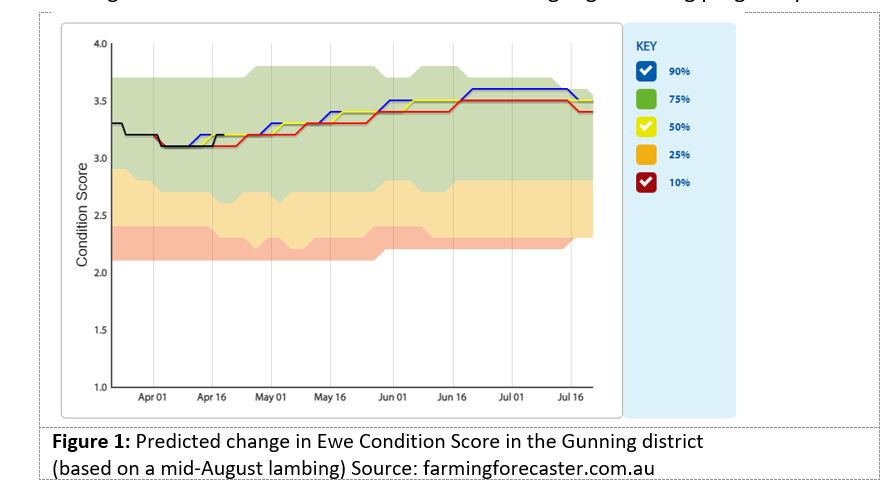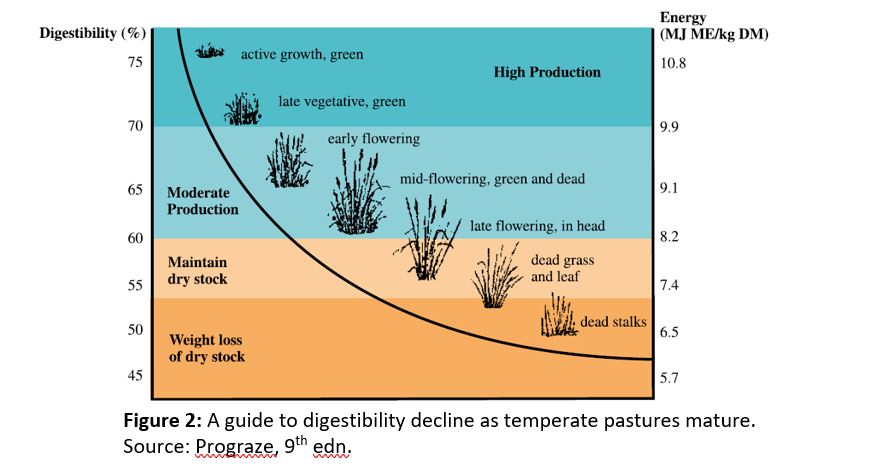Managing feet dystocia and worms in lambing ewes
May 2021
Matthew Lieschke, Senior Agriculture Advisor
Thanks to significant rainfall throughout March the season is once again off to a flying start! Pasture growth rates in the first half of autumn have been exceptional and stock have been putting on weight. General feedback from producers is that livestock are in very good condition.
At present the Bureau of Meteorology is predicting drier than average conditions for the next three months. However, it’s important to note that forecasting accuracy at this time of the year for our region tends is generally LOW (click here to view maps showing forecasting accuracy across the year).
Even if the dry forecast for the next three months proves to be true, modelling data from the decision support tool Farming Forecaster (farmingforecaster.com.au) shows that livestock will continue to put on condition (Figure 1). This is being driven by the fact that:
- soil moisture is above average for this time of the year (at most locations)
- green feed in the paddock is sitting well above average for this time of the year
- pastures are well established and daytime temperatures are starting to cool down, so it won’t take a lot of moisture to keep pastures going.
Livestock are already in good condition and will continue to put on weight. For pregnant stock, weight gain needs to be managed.
Getting weight under control
As 2020 reminded us, good seasons bring their own unique set of challenges. Issues last year included prolapse, foot abscess, dystocia and heavy ewes going down in the lead up to lambing. All these issues stem back to excessive weight gain during pregnancy.
The critical thing right now is to check female condition (i.e. fat score/condition score) as this will determine if you need to apply a nutritional ‘hand brake’ and by how much. Based on experience from previous years, you want to avoid Merino ewes from exceeding Fat Score 3.5 at lambing (Fat Score 4.0 for X bred ewes). Early scanning results are showing a twinning percentage of 60%. The higher the twinning rate the more important it is to manage fat score and prevent them from getting too heavy.
Restricting intake through pasture height
For winter growing/ temperate pasture species (e.g. phalaris, cocksfoot, microlaena, wallaby grass, sub clover, barley grass, annual ryegrass etc.) pasture quality at present will be high (e.g. > 70% digestibility). This will remain the case until these plants start to run up a seed head in spring (Figure 2). Therefore, in most cases the only real option to limit weight gain over the coming months is through managing pasture height.
If the aim is to maintain ewe condition, this involves grazing pastures down and leaving the stock there so that ewes are restricted to around 500 – 600kg DM/ha (Digestible Matter per Hectare), which is a pasture height of around 1.0 – 1.5cm.
If you are aiming for slight weight gain, increase the above targets slightly. Your pasture target will depend on fat score. The higher the fat score, the more important it is to act early and to a greater extent.
Whatever nutritional hand brake you apply, at some point it needs to be released. For twin bearing ewes the pressure needs to be eased four weeks prior to lambing.
Employing the above grazing strategy means that a large portion of your property probably won’t be grazed at all this winter. Don’t be too concerned by this – these paddocks can be dealt with at a later stage. You are better off managing a couple of key paddocks and keeping pastures well grazed as opposed to losing control of pastures across the whole property.
Paddock selection and worms
Start thinking about where you are going to lamb down this year. Paddocks with shorter feed will have higher feed quality and will be better for feet. For twin bearing ewes it would be worth targeting a well-drained/ sloping paddock with no more than 1000kg DM/ha at the start of lambing as they are most prone to developing foot abscess.
Lambing paddocks will need to be grazed over the coming months to manage pasture quality. However, you will need to be careful about what type of stock you put in these paddocks as worm numbers have been increasing rapidly. Cattle are the best option, followed by wethers and then hoggets. If you need to graze lambing paddocks with sheep, it’s important that stock are drenched with an effective drench prior to entry and worm numbers are monitored regularly.
Most drenches are ‘short-acting’ as they only kill adult worms that are inside the sheep at the time of treatment. A short acting drench will give you around 20 days protection where pastures are not being contaminated with worm eggs, as it takes approximately 20 days for a worm to become an adult in the gut and start shedding eggs.
There are several long-acting drenches that provide ongoing control of worms – these tend to contain the actives moxidectin or closantel. While long-acting drenches can be extremely valuable in seasons like this, they need to be used strategically and carefully to avoid increased levels of resistance. It is important to seek advice from your District Vet or local advisor if you are unsure about the best way forward for managing worms.
Note: the South East Circular newsletter provides regular updates on animal health issues, including worms.

